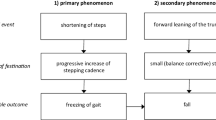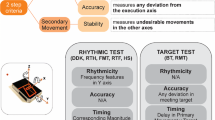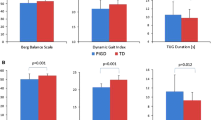Abstract
Tandem gait testing is an integral part of the neurological exam. It is informative in a wide variety of disorders ranging from cerebellar disease to vestibular and peripheral neuropathies, parkinsonism, and other neurodegenerative conditions. We discuss the history and development of tandem gait testing as well as its technique, utility, and limitations in the assessment of neurological conditions. Tandem gait has emerged as a tool in the assessment of cerebellar disease, Huntington disease, idiopathic Parkinson’s disease, atypical parkinsonism, peripheral neuropathies, and vestibulopathies. Its origin can be deduced from experimental observation and clinical experience as far back as the early nineteenth century. Despite the long history and ubiquitous performance of tandem gait testing, there is no standardized, guideline-based protocol to model for more homogenous research and clinical practices. Such a protocol should be developed using historical texts and manuscripts as well as the consensus of the medical research community. With standard protocols, further studies could define the sensitivity of abnormal tandem gait testing in cerebellar disorders, more diffuse neurodegeneration, and peripheral pathologies. Tandem gait can be a useful marker of dysfunction in neurologic conditions whose pathologies extend beyond the vermis or vestibulocerebellar module to include interconnected networks throughout the nervous system.
Similar content being viewed by others
References
Daroff R, Fenichel G, Jankovic J, Mazziotta J (2012) Bradley’s neurology in clinical Practice. Elsevier Inc., Philadelphia, p 6e
Ropper AH, Samuels MA, Klein JP (2014) Chapter 7. Disorders of stance and sait. In: Ropper AH, Samuels MA, Klein JP (eds) Adams & Victor’s principles of neurology. McGraw-Hill, New York, p 10e
Campbell W (2005) Chapter 44. DeJong’s the neurologic examination. Lippincott Williams & Wilkins, Philadelphia, p 6e
Walter H (1990) Ch 69 The Cerebellum. In: Clinical Methods: The history, physical, and laboratory examinations, 3rd edn. Butterworths, Boston
Singer C, Sanchez-Ramos J, Weiner W (1994) Gait abnormality in essential tremor. Mov Disord 9:193–196
Stolze H, Petersen G, Raethjen J, Wenzelburger R, Deuschl G (2001) The gait disorder of advanced essential tremor. Brain 124:2278–2286
Fine E, Ionita C, Lohr L (2002) The history of the development of the cerebellar examination. Semin Neurol 22(4):375-84
Bastian A, Thach W (1995) Cerebellar outflow lesions: a comparison of movement deficits resulting from lesions at the levels of the cerebellum and thalamus. Ann Neurol 38:881–892
Haines DE, Mihailoff GA, Bloedel JR (2002) The cerebellum. In: Haines DE (ed) Fundamental neuroscience, 2nd edn. Churchill Livingstone, New York, pp 424–443
Pryse-Phillips W, Murray T (1992) Essential neurology: a concise textbook. Elsevier, New York
Lindholm B, Nilsson M, Hansson O (2016) External validation of a 3-step falls prediction model in mild Parkinson’s disease. J Neurol 263(12):2462–2469
Aerts M, Esselink R, Abdo W (2016) Ancillary investigations to diagnose parkinsonism: a prospective clinical study. J Neurol 262:346–356
Abdo WF, Borm GF, Munneke M, Verbeek MM, Esselink RA, Bloem BR (2006) Ten steps to identify atypical parkinsonism. J Neurol Neurosurg Psychiatry 77:1367–1369
Maksimovic A, Hanewinckel R, Verlinden V et al (2016) Gait characteristics in older adults with diabetes and impaired fasting glucose: the Rotterdam study. J Diabetes Complicat 30:61–66
McGinty R, McNamara B, Moore H (2015 Nov) DADS neuropathy associated with anti-TNF- α therapy. BMJ Case Rep 25:2015. https://doi.org/10.1136/bcr-2015-211781
Cohen H, Mulavara A, Peters B et al (2013) Sharpening the tandem walking test for screening peripheral neuropathy. South Med J 106:565–569
Cohen H, Mulavara A, Peters B et al (2012) Tests of walking balance for screening vestibular disorders. J Vestib Res 22:95–104
Gowers WR (1888) A manual of diseases of the nervous system. American ed. P. Blakiston, Philadelphia, pp 717–718
Bastian AJ, Mink JW, Kaufman BA, Thach WT (1998) Posterior vermal split syndrome. Ann Neurol 44(4):601–610
Christopher F, Saladin LK (1996) Ch. 9 Disorders of the cerebellum and its connections. In: Pathophysiology of the motor systems: principles and clinical presentations. 1st Ed. F. A. Davis Company
Marquer A, Barbieri G, Perennou D (2014) The assessment and treatment of postural disorders in cerebellar ataxia: a systematic review. Ann Phys Rehabil Med 57:67–78
Huntington Study Group (1996) Unified Huntington’s disease rating scale: reliability and consistency. Mov Disord 11:136–142
Oster E, Eberly S, Dorsey E, Kayson-Rubin E, Oakes D, Shoulson I (2015) Informativeness of early Huntington disease signs about gene status. J Huntingtons Dis 4(3):271–277
Fregly AR, Graybiel A, Smith MJ (1972) Walk on floor eyes closed (WOFEC): a new addition to an ataxia test battery. Aerosp Med 43(4):395–399
Lim E, Seo M, Woo S et al (2005) Relationship between essential tremor and cerebellar dysfunction according to age. J Clin Neurol 1(1):76–80
Rao AK, Gillman A, Louis ED (2011) Quantitative gait analysis in essential tremor reveals impairments that are mainained into advanced age. Gait Posture 34:65–70
Earhart GM, Clark BR, Tabbal SD, Perlmutter JS (2009) Gait and balance in essential tremor: variable effects of bilateral thalamic stimulation. Mov Disord 24(3):386–391
Kronenbuerger M, Konczak J, Ziegler W, Buderath P, Frank B, Coenen VA et al (2009) Balance and motor speech impairment in essential tremor. Cerebellum (Lon- don England) 8(3):389–398
Jankovic J (2002) Essential tremor: a heterogeneous disorder. Mov Disord 17:638–644
Louis et al (2007) Neuropathological changes in essential tremor. Brain 130:3297–3307
Erickson-Davis et al (2010) “Hairy baskets” associated with degenerative purkinje cell changes in essential tremor. J Neuropathol Exp Neurol 69:262–271
Louis E, Rios E, Rao A (2010) Tandem gait performance in essential tremor: clinical correlates and association with midline tremor. Mov Disord 25(11):1633–1638
Louis E, Rao A (2014) Tandem gait performance in essential tremor patients correlates with cognitive function. Cerebellum Ataxias 1:19
Nonnekes J, Aerts M, Abdo W (2014) Medio-lateral balance impairment differentiates between Parkinson’s disease and atypical parkinsonism. J Park Dis 4:567–569
Jankovic J (2015) Gait Disorders. Neurol Clin 33:249–268
Nutt JG, Bastiaan BR, Nir G, Hallet M, Horak FB, Nieuwboer A (2011) Freezing of gait: moving forward on a mysterious clinical phenomenon. Lancet Neurol 10:734–744
Snijders AH, Takakusaki K, Debu B, Lozano AM, Krishna V, Fasano A, Aziz TZ, Papa SM, Factor SA, Hallet M (2016) Physiology of freezing of gait. Ann Neurol 80:644–659
Bloem B, Grimbergen Y, Cramer M et al (2001) Prospective assessment of falls in Parkinson’s disease. J Neurol 248(11):950–958
Dennison A, Noorigian J, Robinson K et al (2007) Falling in Parkinson disease: identifying and prioritizing risk factors in recurrent fallers. Am J Phys Med Rehabil 86(8):621–632
Longridge N, Mallinson A (2010 Jul) Clinical Romberg testing does not detect vestibular disease. Otol Neurotol 31(5):803–806
Kammerlind A, Larsson P, Ledin T et al (2005) Reliability of clinical balance tests and subjective ratings in dizziness and disequilibirum. Adv Physiother 7:96–107
Fregly A, Smith M, Graybiel A (1973 Jan) Revised normative standards of performance of men on a quantitative ataxia test battery. Acta Otolaryngol 75(1):10–16
Speers R, Ashton-Miller J, Schultz A et al (1998) Age differences in abilities to perform tandem stand and walk tasks of graded difficulty. Gait Posture 7(3):207–213
Vereeck L, Wuyts F, Truijen S et al (2008) Clinical assessment of balance: normative data, and gender and age effects. Int J Audiol 47(2):67–75
Tinetti M, Speechley M (1989) Prevention of falls among the elderly. NEJM 320:1055–1059
Brooks AM, Snedden TR, Mixis B, Hetzel S, McGuine TA (2017) Establishing baseline normative values for the children sport concussison assessment tool. JAMA Pediatr 171(7):670–677
Oldman JR, DiFabio MS, Kaminski TW, DeWolf RM, Buckley TA (2016) Normative tandem gait in collegiate student-athletes: implications for clinical concussion assessment. Sports Health 9(4):305–311
Blumenfeld H (2002) Neuroanatomy through clinical cases. Sinauer Associates Inc., Sunderland
Dozza M, Wall C, Peterka R et al (2007) Effects of practicing tandem gait with and without vibrotactile biofeedback in subjects with unilateral vestibular loss. J Vestib Res 17(4):195–204
Author information
Authors and Affiliations
Corresponding author
Ethics declarations
Conflicts of interest
The authors declare that they have no conflict of interest.
Rights and permissions
About this article
Cite this article
Margolesky, J., Singer, C. How tandem gait stumbled into the neurological exam: a review. Neurol Sci 39, 23–29 (2018). https://doi.org/10.1007/s10072-017-3108-1
Received:
Accepted:
Published:
Issue Date:
DOI: https://doi.org/10.1007/s10072-017-3108-1




